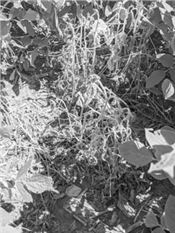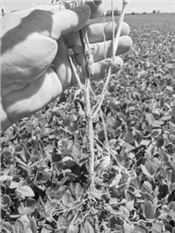|
Phytophthora Root And Stem Rot Being Observed In Some Soybean Fields
DR. CARL A. BRADLEY
PRINCETON, KY.
In parts of the state where wet weather has continued through the season so far, one of the diseases being observed is Phytophthora root and stem rot, which is caused by the oomycete (aka water mold) pathogen Phytophthora sojae. This pathogen can survive in the soil for many years. Under wet soil conditions, especially in poorly drained soils, this pathogen can infect soybean plants at any stage. Symptoms of this disease include dark-colored rotted roots and a dark-colored lesion that will extend from the roots onto the stem (Figure 1). Plants that are affected severely may wilt and die prematurely (Figure 2).
Disease Management
Unfortunately, there are no “in-season” practices that can be applied to manage Phytophthora root rot. The most important practice used to manage Phytophthora root rot is to plant resistant soybean varieties.
Two different types of resistance to Phytophthora root rot may be utilized by soybean breeders when developing soybean varieties.
Some soybean varieties may contain single genes for resistance, known as Rps genes. Seed company catalogs often will list which Rps genes appear in a soybean variety, if any. These Rps genes are highly effective in managing Phytophthora root rot as long as there are no races of the pathogen that can overcome that specific resistance gene. Recently-conducted research supported by the Kentucky Soybean Board and in collaboration with The Ohio State University, showed that there are several races of the P. sojae present in Kentucky that are able to overcome many of the Rps genes present in common soybean varieties. So, although Rps genes are still effective in managing Phytophthora root rot, there may be some fields that contain races of P. sojae that would limit the effect of some Rps genes.
The other type of resistance used goes by different names, such as partial resistance, field tolerance, etc., and is usually provided in seed catalogs as a scale (1-9, etc.). This type of resistance does not provide complete resistance, but it is not race-specific. Therefore, in fields where Rps genes are not effective, a variety with a high level of partial resistance will still be productive in spite of Phytophthora root rot being present. The best variety choice for management of Phytophthora root rot will include an above-average rating for partial resistance as well as an effective Rps gene.
An additional way to help manage Phytophthora root rot, along with resistant varieties, is to treat the seed with metalaxyl, mefenoxam, and/or ethaboxam. In some cases, the highest labeled rate of these seed treatments may need to be applied to achieve the best level of control. Although these seed treatments will provide some protection against infection for a few weeks, they will not provide season-long control; therefore, it is important that a resistant variety is used in fields where Phytophthora is a known problem. ∆
DR. CARL A. BRADLEY: Plant Pathology Extension Specialist, University of Kentucky

Figure 2. Soybean plants wilting and dying prematurely due to Phytophthora root and stem rot
Photos: Carl Bradley, UK

Figure 1. Soybean roots and stem affected by Phytophthora root and stem rot
|
|